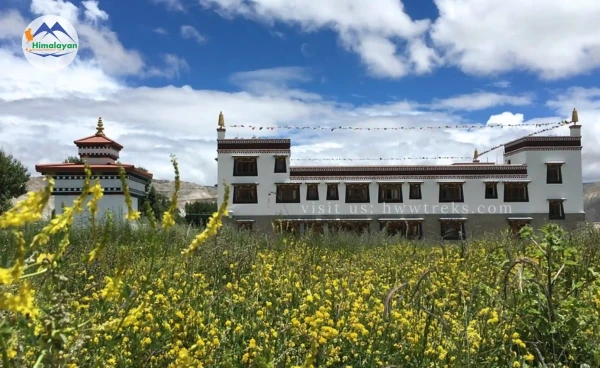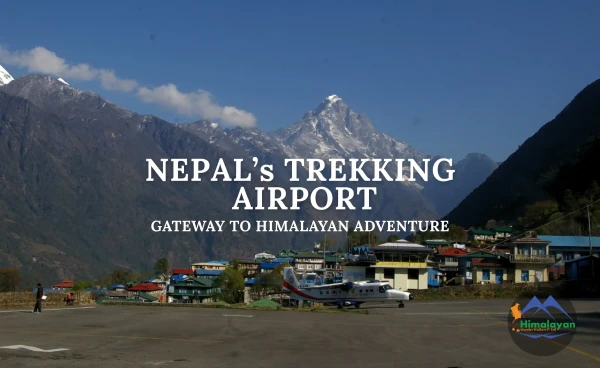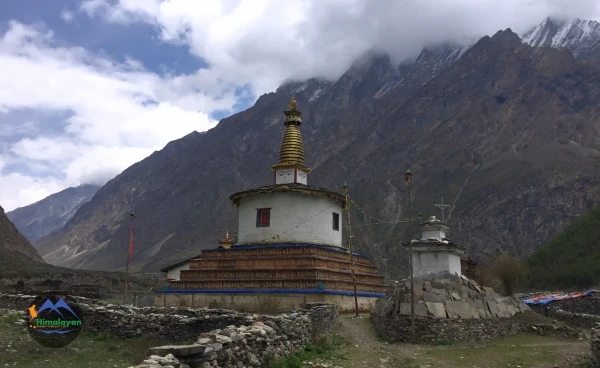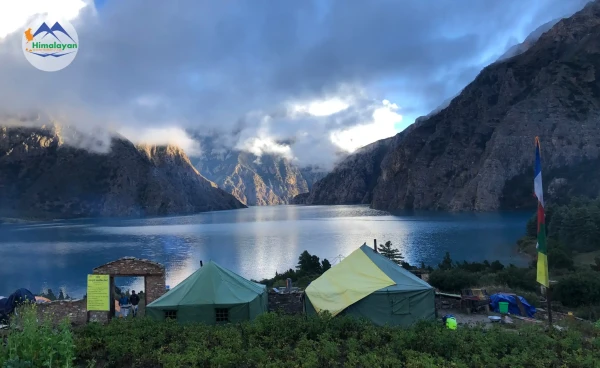- 10/24/2025
- Himalayan Wander Walkers
Hotels in Upper Mustang: Complete Accommodation Guide for Visitors
The Upper Mustang, once a Forbidden Kingdom, protected behind the Annapurna and Dhaulagiri Mountain Range, now welcomes visitors from all over the world. Travelers are amazed by its dramatic landscape, culture, tradition, and the colorful Tiji and Yartung festivals. But before traveling and ready to capture the Kingdom's beauty, one main question that you need to consider is where to stay or how to choose the right accommodation.
Despite being a small village in the Himalayan region, Upper Mustang has developed a wide range of shelter options for visitors and trekkers, catering to their preferences and budgets. From the medieval walled city of Lo Manthang to the red cliffs of Dhakmar and the gateway village of Kagbeni, accommodation options have improved significantly. Whether you're looking for basic teahouses or comfortable lodges with modern amenities, Upper Mustang offers a range of housing options that strike a balance between traditional hospitality and essential trekking facilities.
This complete accommodation guide covers hotels and guest houses across all major and minor villages in Upper Mustang, along with their accessible contact details:
Contents [hide]
- Hotels and Guest house in Lo Manthang
- Hotel and Guest house in Chhoser
- Hotel and Guest house in Chharang
- Hotel and Guest house in Dhakmar
- Hotels and Guest house in Ghami
- Hotels and Guest hosue in Ghiling
- Hotels and Guest house in Sangboche/ Sangmochen
- Hotels and Guest house in Samar
- Hotels and Guest house in Chele
- Hotels and Guest house in Chhusang
- Hotels and Guest house in Yara
- Hotels and Guest hosue in Dhye Khola
- Hotels and Guest house in Ghara
- Hotels and Guesthouse in Tange
- Hotels and Guest house in Dhi
- Hotels and Guest house in Kagbeni
- Best Time to Visit Upper Mustang
- How to book hotels in Upper Mustang?
- Conclusion
Hotels and Guest house in Lo Manthang
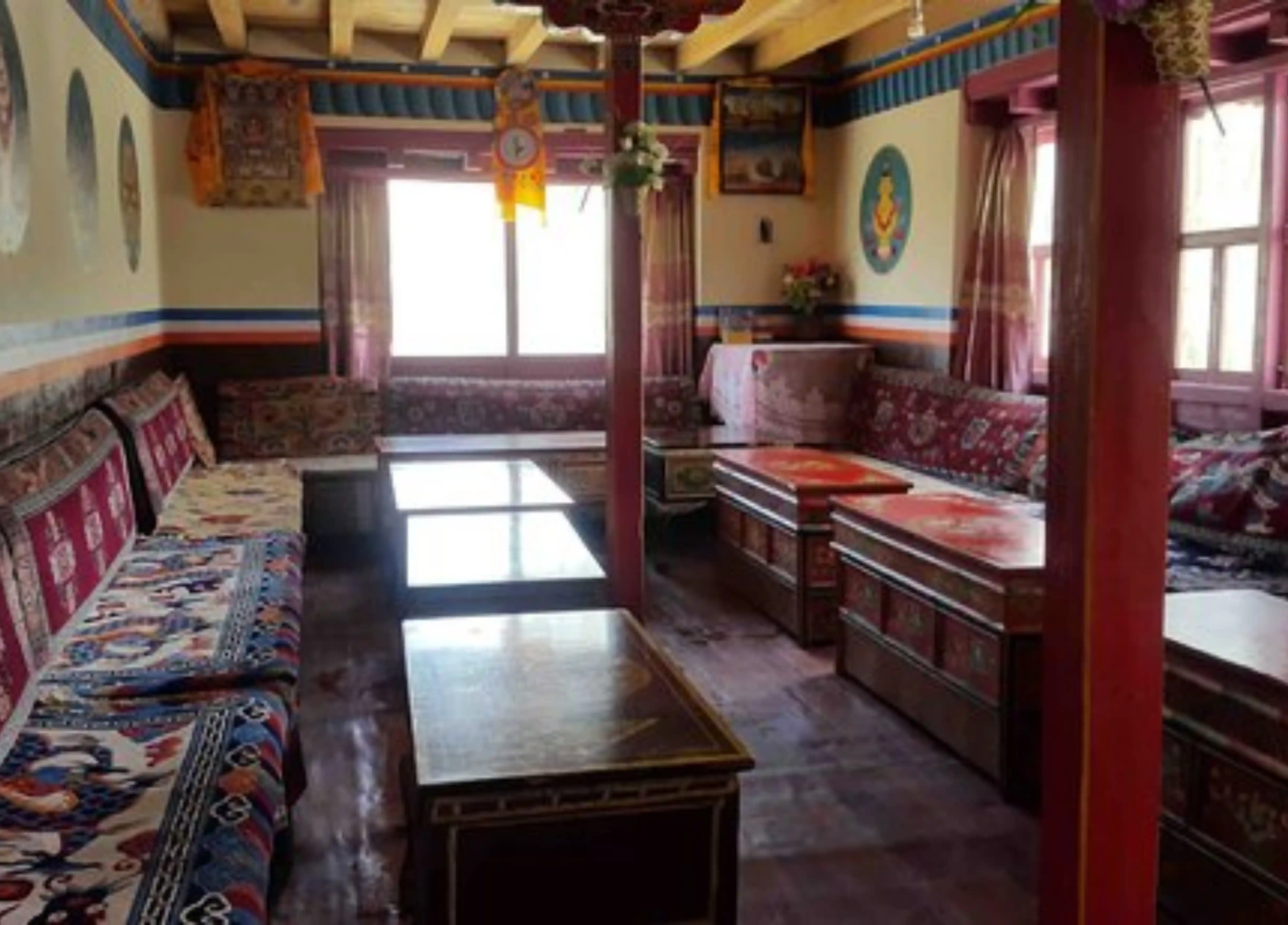 The Lo Manthang village, which once served as the Ancient Walled Capital City of the former Lo Kingdom, is now the heart of the Upper Mustang. The village is surrounded by mud brick with two main gates at the north and south sides. Lying at an elevation of about 3,800 meters, this centuries-old town becomes one of the busiest and energetic villages among others during trekking seasons. Over the years, Lo Manthang has been increasingly rising towards modernization, along with the historic charm still prevailing, where one can witness the old and famed monasteries and former royal palaces. In Lo Manthang, one can enjoy all the modern conveniences, including WIFI, cafes, restaurants, entertainment, proper mobile networks, and so on. Despite all the modern trade, Lo Manthang still retains its timeless beauty with locals in their traditional attire and continuing their centuries-old practices and festivals. There are several guest houses and teashops offering accommodation services from luxury to basic comfort, with options ranging from traditional homestays to resort and lodges with attached bathrooms. Most of the shelter provides simple meals, including the local Dhal Bhaat, noodles, and Tibetan breads, but you can request or order the food of your liking based on the place you are staying. Here are some of the main hotels and guest houses available in Lo Manthang:
The Lo Manthang village, which once served as the Ancient Walled Capital City of the former Lo Kingdom, is now the heart of the Upper Mustang. The village is surrounded by mud brick with two main gates at the north and south sides. Lying at an elevation of about 3,800 meters, this centuries-old town becomes one of the busiest and energetic villages among others during trekking seasons. Over the years, Lo Manthang has been increasingly rising towards modernization, along with the historic charm still prevailing, where one can witness the old and famed monasteries and former royal palaces. In Lo Manthang, one can enjoy all the modern conveniences, including WIFI, cafes, restaurants, entertainment, proper mobile networks, and so on. Despite all the modern trade, Lo Manthang still retains its timeless beauty with locals in their traditional attire and continuing their centuries-old practices and festivals. There are several guest houses and teashops offering accommodation services from luxury to basic comfort, with options ranging from traditional homestays to resort and lodges with attached bathrooms. Most of the shelter provides simple meals, including the local Dhal Bhaat, noodles, and Tibetan breads, but you can request or order the food of your liking based on the place you are staying. Here are some of the main hotels and guest houses available in Lo Manthang:
| Hotel/ Guest house Name | Contact Number |
| Royal Mustang Resort | +977 985-6033555 |
| Hotel Mandala | +977 985-1211673 |
| Tashi Delek Guest House | +977 985-6075635 |
| Himalayan Guest House | +977 985-6044460 |
| Hotel Tri-Bhadrika | +977 984-3720666 |
| Hotel Caravan | +977 974-1888077 |
| Potala Hotel | +977 9840603663 |
| Mystique Guest House | +977 984-4738000 |
| Lotus Holiday Inn | +977 984-3406272 |
| Hotel Peace | +977 984-7050154 |
| Norling Guesthouse | +977 984-0591479 |
| Zambala Guesthouse | +977 986-6060371 |
| Tibet Guest House | N/A |
| Korala Guest House | N/A |
Note: Accommodation prices of these hotels fluctuate based on peak trekking seasons and cultural celebrations, particularly during the Tiji Festival and Yartung Festival when demand is highest.
Hotel and Guest house in Chhoser
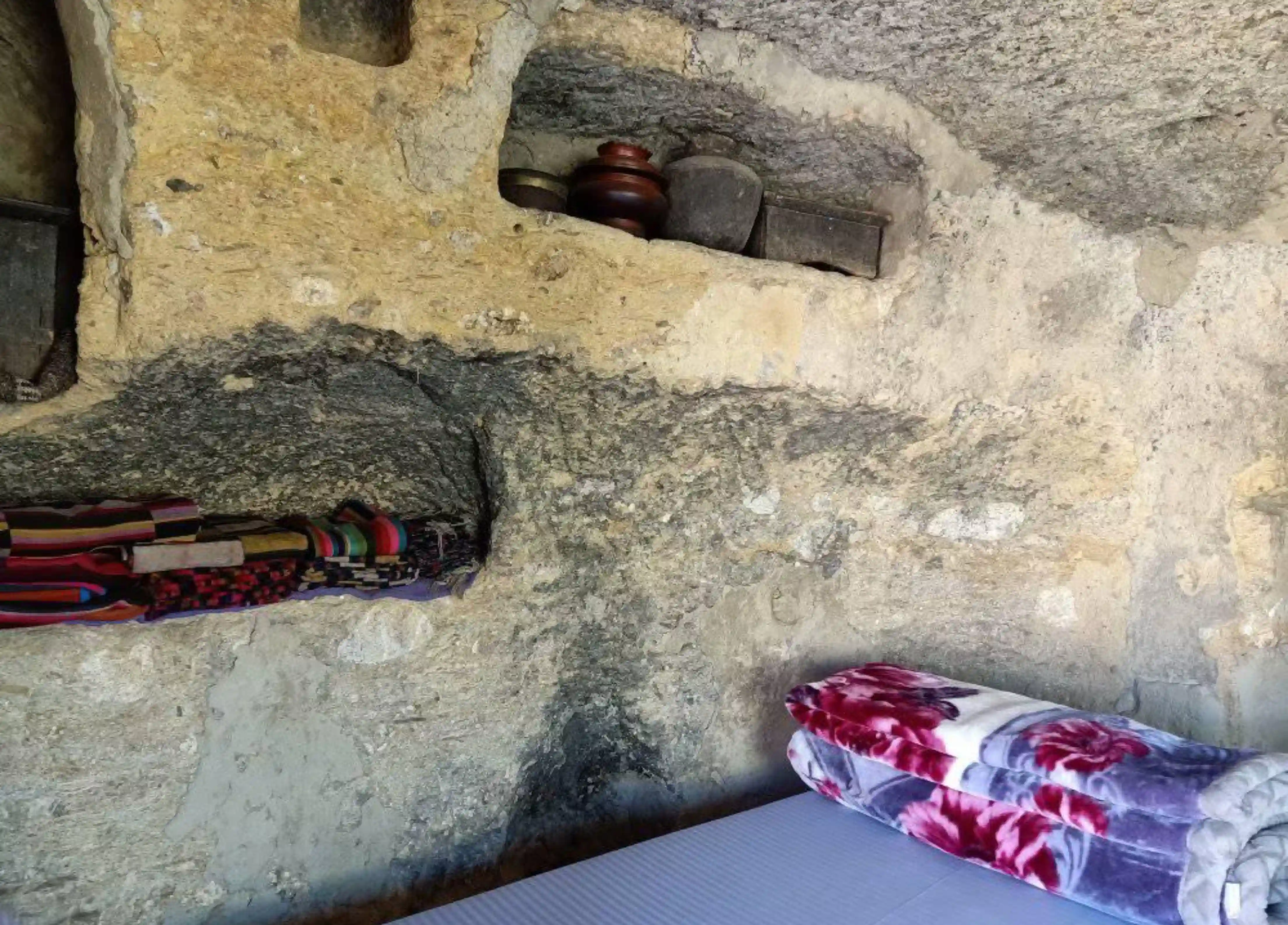 To the east of Lo Manthang lies a valley called Chosar or also spelled as” Tso sher”. This valley contains five scattered villages named Arka, Bacha, Garphu, Nyiu, and Shija, each maintaining its charm with stone houses, a barley field, and locals with traditional attire. The Chosar valley is famous for its multi-story and dramatic caves, which were once used to be a home and meditation chamber for the locals of that place. Most of the tourists are attracted to the five-story Shiza Daong cave, which has more than 40 different rooms. The valley has remained relatively untouched by tourism and modernization, as compared to Lo Manthang, which gives a reason for the travelers to spend a night and enjoy the authentic glimpse of local tradition and culture. The valley is home to the famous Rinchenling cave monastery and the breathtaking Kunchowling. In recent years, a few basic guest houses have opened that accommodate travelers exploring the valley thoroughly. They are listed below:
To the east of Lo Manthang lies a valley called Chosar or also spelled as” Tso sher”. This valley contains five scattered villages named Arka, Bacha, Garphu, Nyiu, and Shija, each maintaining its charm with stone houses, a barley field, and locals with traditional attire. The Chosar valley is famous for its multi-story and dramatic caves, which were once used to be a home and meditation chamber for the locals of that place. Most of the tourists are attracted to the five-story Shiza Daong cave, which has more than 40 different rooms. The valley has remained relatively untouched by tourism and modernization, as compared to Lo Manthang, which gives a reason for the travelers to spend a night and enjoy the authentic glimpse of local tradition and culture. The valley is home to the famous Rinchenling cave monastery and the breathtaking Kunchowling. In recent years, a few basic guest houses have opened that accommodate travelers exploring the valley thoroughly. They are listed below:
| Hotel/Guest house Name | Contact Number |
| Lo Chhosar Guest House | +977 9867891213 |
| Cave City Guest House | +977 9848252923 |
| Shelkar Guest House | +977 9867700937 |
Hotel and Guest house in Chharang
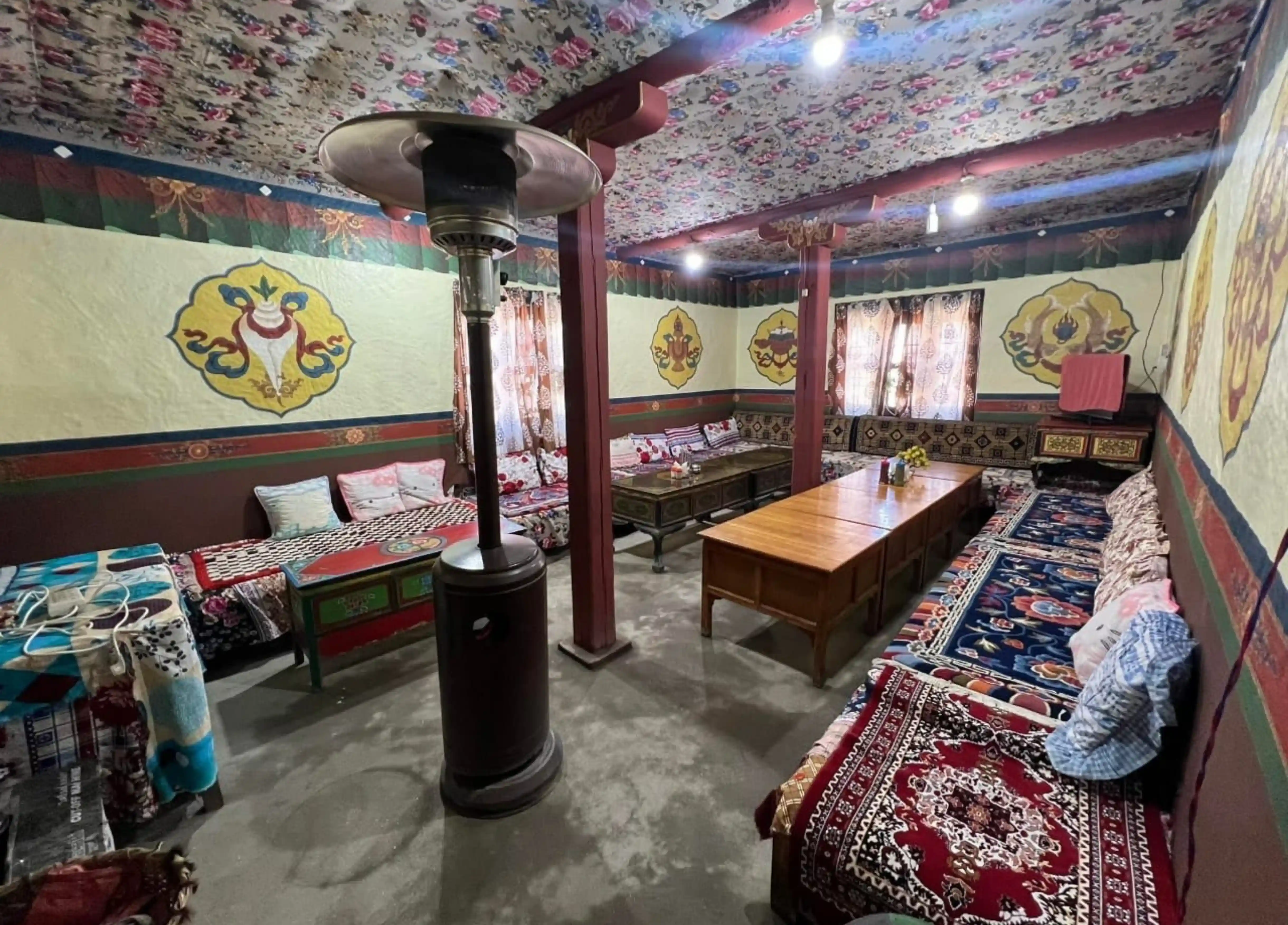 Chharang, also spelled as “Tsarang,” is the second largest settlement in the Upper Mustang after Lo Manthang. This village dramatically sits at an altitude of 3,575 meters, along with its ancient palace and its 14th-century monastery. This monastery is one of the major religious structures of the Charang village, with beautiful wall paintings and statues inside. This village serves as an administrative center for Dalome Rural Municipality and a stopover point for travelers heading to or from Lo Manthang. It has still maintained its traditional whitewashed houses along with the terraced fields growing barley, buckwheat, and potatoes as main products. Lately, Charang has been developed with several guest houses and lodges offering better facilities for travelers. The village has all the modern basic needs that one searches for, including wifi, electricity, hot water, preferred cuisine, and so on. There are also small shops selling snacks and basic supplies for travelers and trekkers. Here are some of the main hotels and guest houses available in Charang:
Chharang, also spelled as “Tsarang,” is the second largest settlement in the Upper Mustang after Lo Manthang. This village dramatically sits at an altitude of 3,575 meters, along with its ancient palace and its 14th-century monastery. This monastery is one of the major religious structures of the Charang village, with beautiful wall paintings and statues inside. This village serves as an administrative center for Dalome Rural Municipality and a stopover point for travelers heading to or from Lo Manthang. It has still maintained its traditional whitewashed houses along with the terraced fields growing barley, buckwheat, and potatoes as main products. Lately, Charang has been developed with several guest houses and lodges offering better facilities for travelers. The village has all the modern basic needs that one searches for, including wifi, electricity, hot water, preferred cuisine, and so on. There are also small shops selling snacks and basic supplies for travelers and trekkers. Here are some of the main hotels and guest houses available in Charang:
| Hotel/ Guest house Name | Contact Number |
| Dolma Hotel | +977 9828115650 |
| Maya's Heritage Inn | +977 9861003389 |
| Lumbini Guest House and Restaurant | N/A |
Hotel and Guest house in Dhakmar
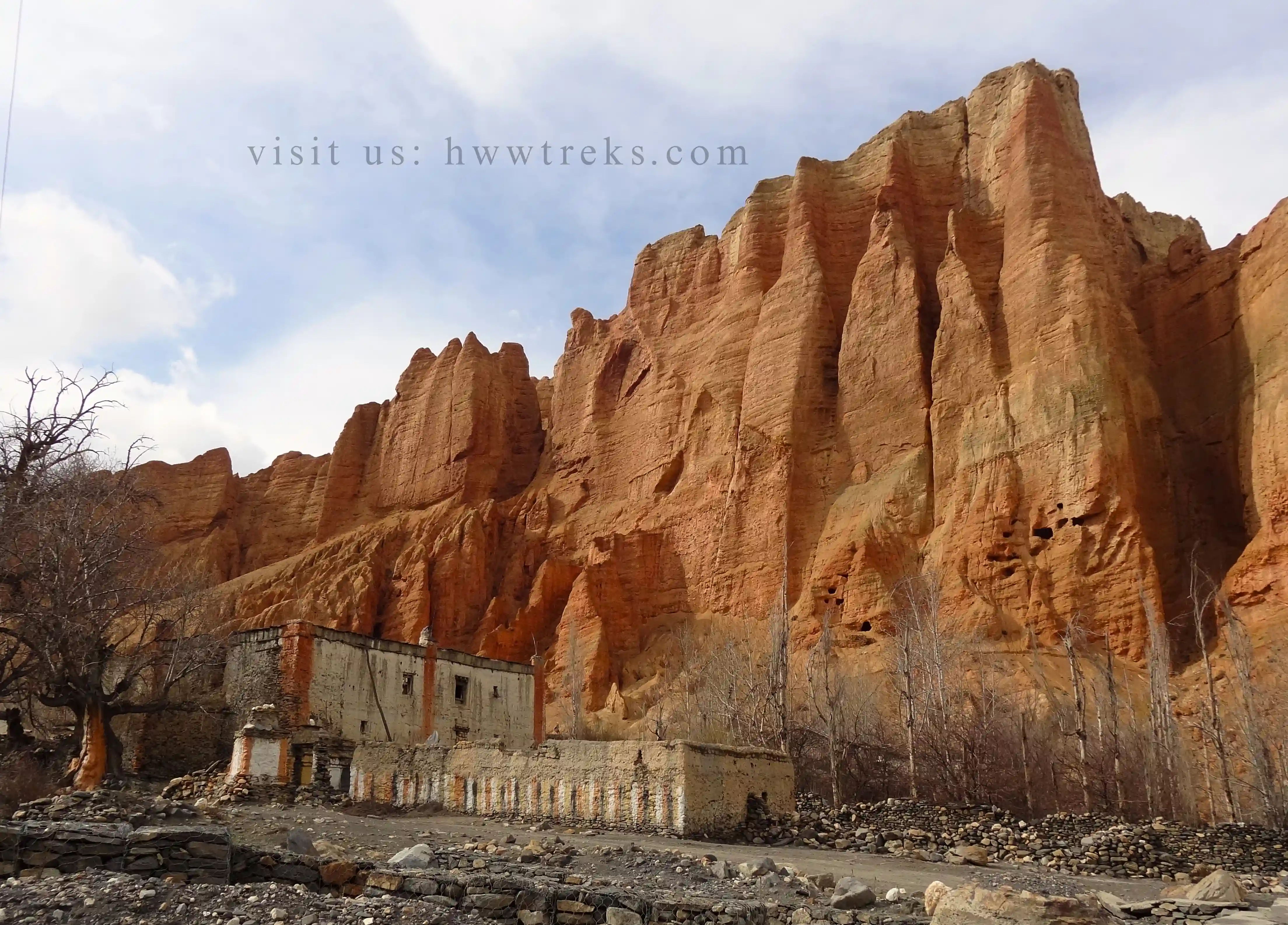
Mustang is and has always been famous for its striking landscape and architecture. Likewise, Upper Mustang's famous red cliff lies in a village named after the red cliff itself, i.e., Dhakmar, where Dhak means cliff and mar means red. The village sits at an elevation of 3,810 meters and is famous for its dramatically positioned ochre colored cliff that is stretched from east to west. Based on a local legend related to Guru Padma Sambhava, the redness of the cliff is the blood of an evil spirit, and science has its own reason. The village has only a few countable households practicing traditional farming and animal husbandry. Trekkers are highly recommended to visit this village not only for the cliff but also for the ancient Ghar Gompa, which is considered one of the oldest monasteries in the entire Mustang region. Nowadays, Dhakmar has two or three basic guest houses offering simple accommodation and meals. The village is still lost in its own authentic charm with minimal modern development, prayer flags fluttering in the wind, and locals still wearing traditional Tibetan-style clothing while going about their daily routines. List of hotels and homestays in Dhakmar is given below:
| Hotel/ Guest house Name | Contact Number |
| Tenzin River Side Hotel | +977 9867766419 |
| KC Heaven Hotel | +977 9860113740 |
| Red Cliff Homestay | N/A |
| Gompa Homestay | N/A |
Hotels and Guest house in Ghami
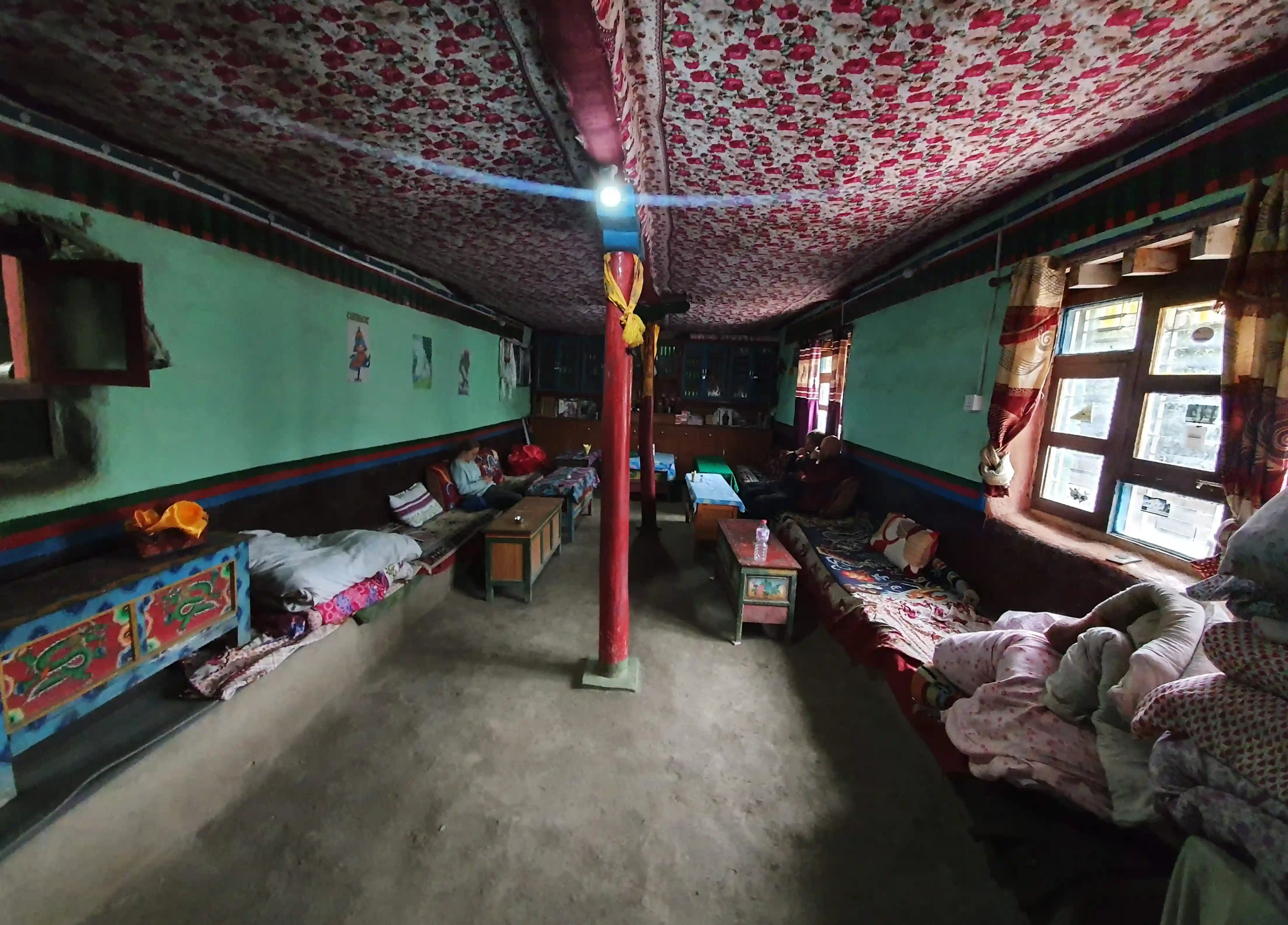 Ghami village is one of the most pleasant and fertile villages among the other higher villages of Upper Mustang. It has a warmer climate and better environment for cultivation, where fields and scattered trees have a greener landscape. The village comes to life during the summer season when the fields are decorated with buckwheat and mustard, creating a shade of pink, yellow, and green. Ghami lies about two house walks from Nyi La pass via Ghiling village. The village is especially famous for its thousand or prayer stones, which is the longest mani wall in Nepal. The village has evolved into a suitable stop off for trekkers with several teahouses and guest houses offering accommodation and meals. These guest houses provide basic yet comfortable rooms along with modern amenities. The village is gradually moving toward modernization, though it still maintains its peaceful and local atmosphere.
Ghami village is one of the most pleasant and fertile villages among the other higher villages of Upper Mustang. It has a warmer climate and better environment for cultivation, where fields and scattered trees have a greener landscape. The village comes to life during the summer season when the fields are decorated with buckwheat and mustard, creating a shade of pink, yellow, and green. Ghami lies about two house walks from Nyi La pass via Ghiling village. The village is especially famous for its thousand or prayer stones, which is the longest mani wall in Nepal. The village has evolved into a suitable stop off for trekkers with several teahouses and guest houses offering accommodation and meals. These guest houses provide basic yet comfortable rooms along with modern amenities. The village is gradually moving toward modernization, though it still maintains its peaceful and local atmosphere.
| Hotel/ Guest house Name | Contact Number |
| Lo Ghami Guest House | +977 9846743498 |
| Hotel Royal Mustang | +977 9857650678 |
Hotels and Guest hosue in Ghiling
At an altitude of 3,340 meters, Ghiling village is located beneath a unique rocky mountain. The village is separated into two sections, where the right side holds the Shree Janajyoti Basic School and the left side covers the residential area. There is an ancient central monastery that serves as both a spiritual and community hub for the village. Ghiling has been developing continuously toward infrastructure and basic amenities in recent years. The village has better access to electricity, and there are a number of hotels and teahouses open for visitors. These hotels provide basic rooms, meals, and tea. Walking through Ghiling's dusty streets, you'll find small shops selling basic supplies, prayer wheels, chortens, and friendly locals going about their daily activities of farming and animal herding, maintaining the traditional lifestyle that has existed here for centuries. Hotels of Ghiling villages include:
| Hotel/ Guest house Name | Contact Number |
| Kunga Restaurant and Hotel | +977 9857650327 |
| Darjeeling Hotel | N/A |
| Potala Hotel | N/A |
| Tibet Hotel | N/A |
| Hotel the Norbuling & Restaurant | +977 9846323564 |
Hotels and Guest house in Sangboche/ Sangmochen
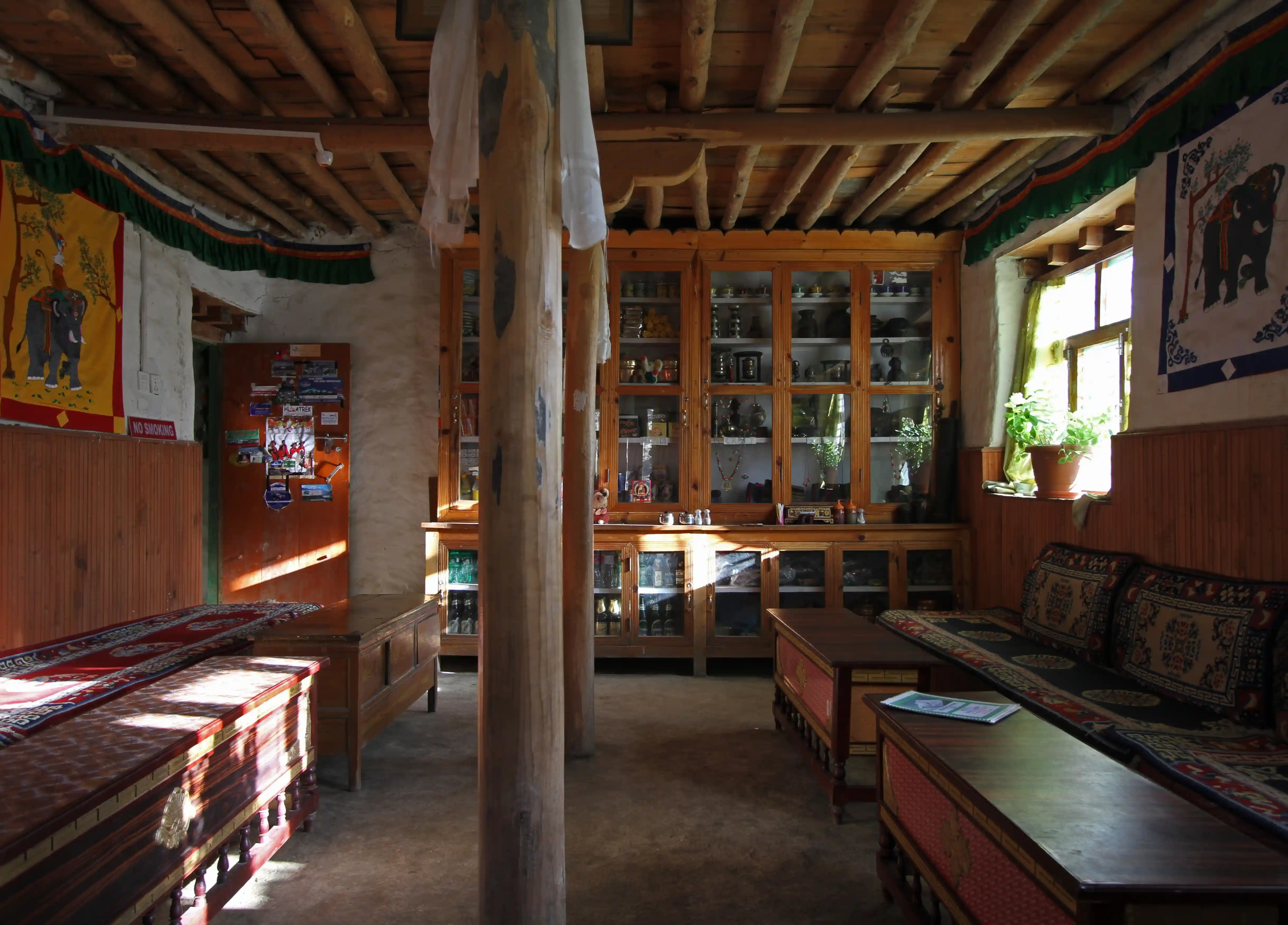
Sangboche, also known as “Sangmochen,” is a small village in Upper Mustang that consists of only four or five houses. This village has a strong and fascinating story connected to Guru PadmaSambhava, a tantric Buddhist Master. While chasing a demon, Guru PadmaSambhava met a girl, and she introduced herself as Sangmo and told him she saw a terrifying woman running towards Tamagaon. Since then, the encounter gave the village the name “Sangmochen,” where Sangmo is the girl's name and chen means place. The village is conveniently located about half an hour's walk from Bhena and roughly one hour from the sacred Chungshi Rangjung Cave Monastery, making it a practical overnight stop along the trekking route. Even though it is a small village, it has everything you will need to quench your tiredness. Today, Sangmochen provides all the basic amenities for trekkers, including electricity from a solar panel, WIFI, hot water, basic supplies, and the warm hospitality of lodge owners who understand the needs of tired hikers traversing the challenging terrain of Upper Mustang. List of hotels in Sangboche is:
| Hotel/ Guest house Name | Contact Number |
| Dhaulagiri Hotel | +977 9847707278 |
| Nilgiri Hotel | +977 9867687282 |
| Chungsi Guest House | N/A |
Hotels and Guest house in Samar
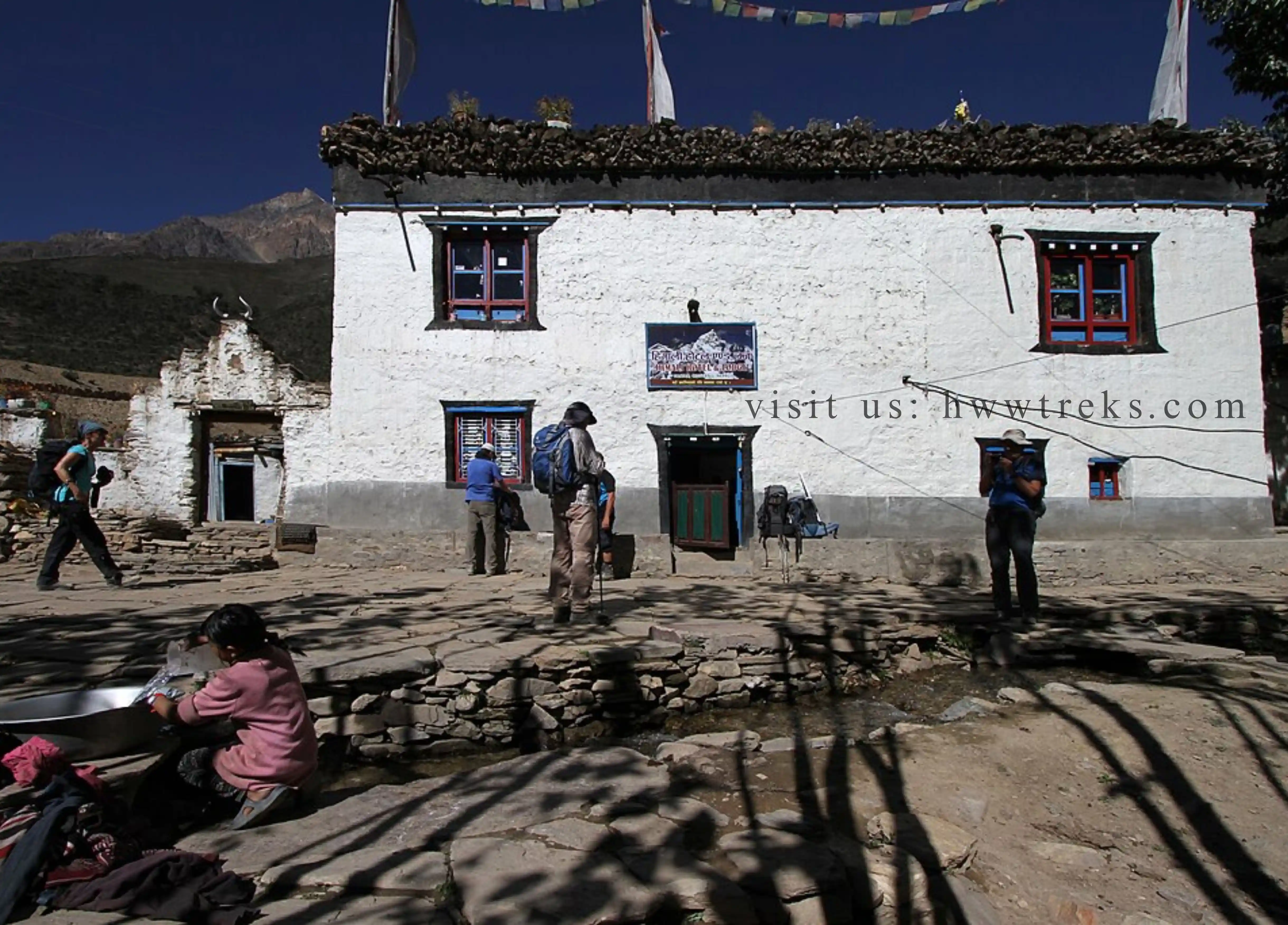 Samar is a small village consisting of 12-14 houses. It has a different landscape that feels distinctly different from other villages in the region, with a slightly greener environment. The village has maintained its traditional look with stone houses and prayer flags surrounding the small chortens. People are mainly busy with farming and animal herding. Recent road construction has brought both benefits and challenges, with the new motor road bypassing the village center, reducing foot traffic but increasing dust. Despite this change, Samar remains an important junction point for trekkers where they stop for lunch and a tea break. The village also has hotels and guest house facilities where trekkers can stay overnight. There, they provide simple rooms with traditional and local meals to refuel the tired hikers. Some of the main stopover hotels for Samar village are:
Samar is a small village consisting of 12-14 houses. It has a different landscape that feels distinctly different from other villages in the region, with a slightly greener environment. The village has maintained its traditional look with stone houses and prayer flags surrounding the small chortens. People are mainly busy with farming and animal herding. Recent road construction has brought both benefits and challenges, with the new motor road bypassing the village center, reducing foot traffic but increasing dust. Despite this change, Samar remains an important junction point for trekkers where they stop for lunch and a tea break. The village also has hotels and guest house facilities where trekkers can stay overnight. There, they provide simple rooms with traditional and local meals to refuel the tired hikers. Some of the main stopover hotels for Samar village are:
| Hotels/ Guest house Name | Contact Number |
| Himali Hotel | +977 9847680556 |
| Hotel Annapurna | N/A |
Hotels and Guest house in Chele
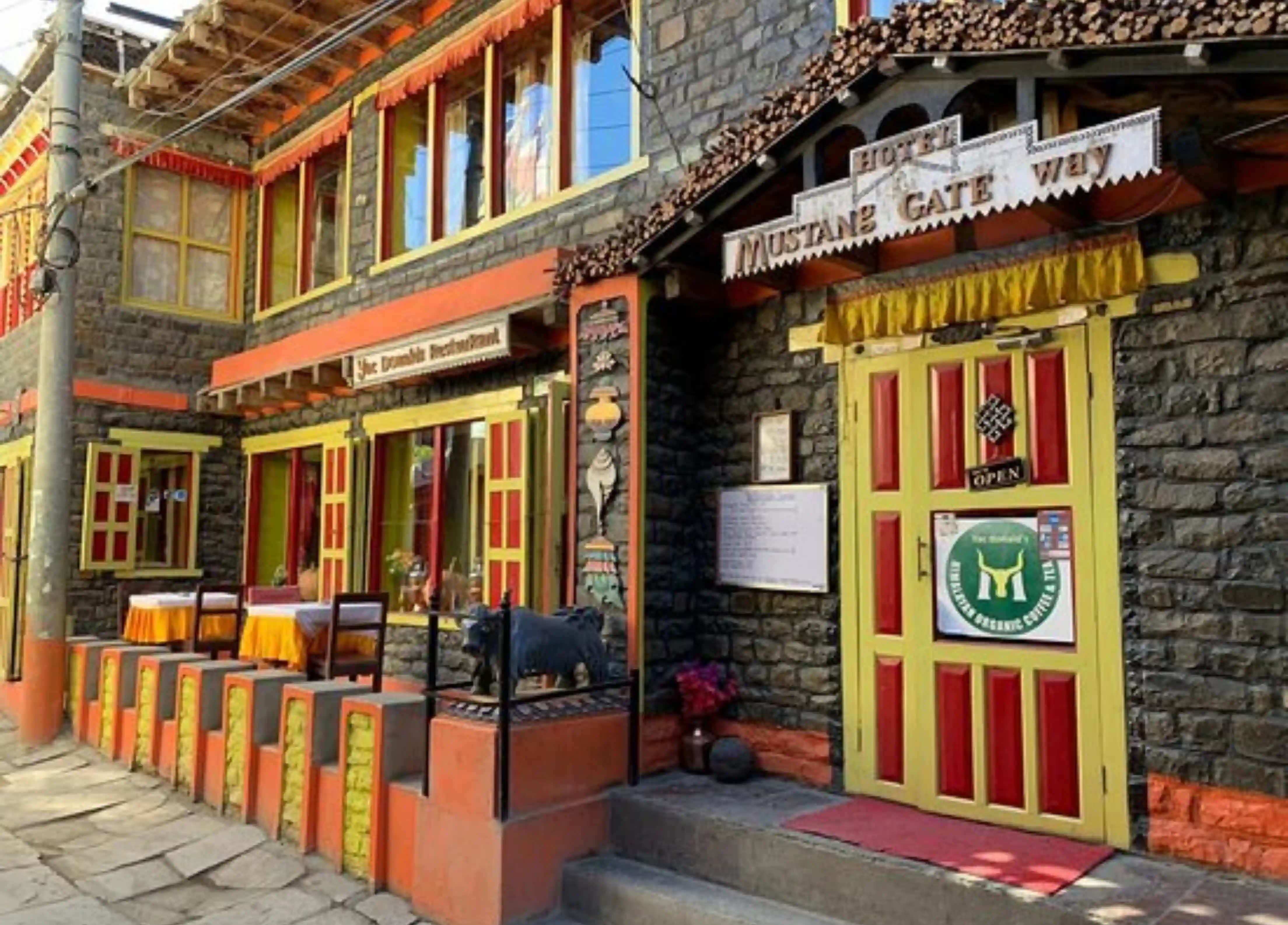 Chele village is situated at an altitude of 3,050 meters and lies about an hour's walk from Chhusang along the Upper Mustang trekking route. This interesting settlement is positioned dramatically on the edge of a canyon overlooking the Kali Gandaki River below, creating a striking location with sweeping views of the surrounding barren landscape. This village has a strong afternoon wind sweeping through the village, raised from the Kali Gandaki River gorge. Despite the heavy wind, Chele offers a warm welcome to the trekkers. The village has electricity, though solar panels are common as backup power sources, and some lodges offer hot showers and device charging facilities. The village has a few guest houses providing basic shelter with simple rooms to slightly better rooms with attached facilities. One can find hot meals such as dal bhat, fried rice, noodle soups, momos, Tibetan bread, and plenty of tea to warm up tired trekkers. Some of these guest houses include:
Chele village is situated at an altitude of 3,050 meters and lies about an hour's walk from Chhusang along the Upper Mustang trekking route. This interesting settlement is positioned dramatically on the edge of a canyon overlooking the Kali Gandaki River below, creating a striking location with sweeping views of the surrounding barren landscape. This village has a strong afternoon wind sweeping through the village, raised from the Kali Gandaki River gorge. Despite the heavy wind, Chele offers a warm welcome to the trekkers. The village has electricity, though solar panels are common as backup power sources, and some lodges offer hot showers and device charging facilities. The village has a few guest houses providing basic shelter with simple rooms to slightly better rooms with attached facilities. One can find hot meals such as dal bhat, fried rice, noodle soups, momos, Tibetan bread, and plenty of tea to warm up tired trekkers. Some of these guest houses include:
| Hotels/ Guest house Name | Contact Number |
| Mustang Gate Hotel | +977 9843134902 |
| Bishal Guest House | N/A |
Hotels and Guest house in Chhusang
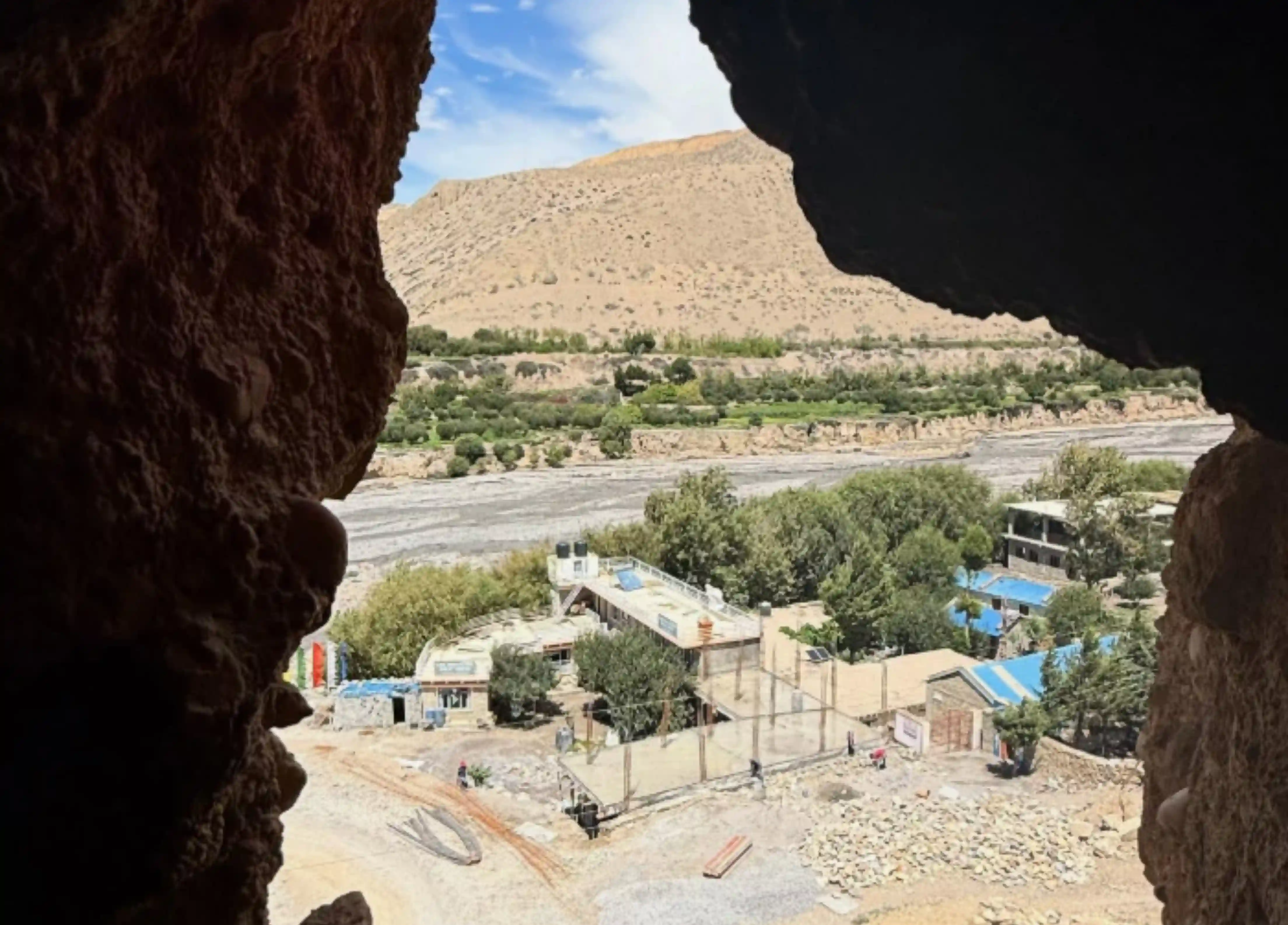 Chhusang, most commonly and locally preferred as “Chuksang,” is a large village split into two by the Narsing River. Unlike other barren and dry villages in Mustang, Chuksang has a fertile field benefiting from agriculture, whether it be growing wheat, barley, buckwheat, peas, mustard, or fruits like apples, apricots, and other seasonal foods. During the farming season, the village looks full of life and color. Chuksang has preserved its authenticity and charms while offering basic facilities to travelers, making their overnight stay warm and cozy. The village has several guest houses and lodges offering comfortable rooms with warm meals and key conveniences. In earlier times, it was demanding and risky to cross the Narsing River, but nowadays, due to modern infrastructure, solid bridges have made it an easy and safe walk for both residents and visitors to travel. List of hotels and guest houses in Chuksang village includes:
Chhusang, most commonly and locally preferred as “Chuksang,” is a large village split into two by the Narsing River. Unlike other barren and dry villages in Mustang, Chuksang has a fertile field benefiting from agriculture, whether it be growing wheat, barley, buckwheat, peas, mustard, or fruits like apples, apricots, and other seasonal foods. During the farming season, the village looks full of life and color. Chuksang has preserved its authenticity and charms while offering basic facilities to travelers, making their overnight stay warm and cozy. The village has several guest houses and lodges offering comfortable rooms with warm meals and key conveniences. In earlier times, it was demanding and risky to cross the Narsing River, but nowadays, due to modern infrastructure, solid bridges have made it an easy and safe walk for both residents and visitors to travel. List of hotels and guest houses in Chuksang village includes:
| Hotels/Guest house Name | Contact Number |
| Cave Monastery Guest House | +977 9846069046 |
| Bhrikuti Guest House | +977 9846848287 |
| Braka Guest House | +977 9765628538 |
| Hotel Alice | +977 9857650790 |
Hotels and Guest house in Yara
Yara is a remote traditional village decorated with its distinctive mud brick houses and surrounded by black rock hills. The village is famous for its ancient multi-story caves, which are believed to have man made thousands of years ago for settlements. This village is warmer as compared to other villages of Upper Mustang, and its apple agriculture is very famous. Farming and agriculture are their primary occupation, where they grow wheat, buckwheat, barley, along with Yak and goat rearing. Yara village has limited places to stay at night. There are 2 to 3 guest houses where you can find comfy yet simple beds after a long day. Even though the modernization is touching the Yara village, it has still protected and preserved their settlements, offering travelers an authentic experience of traditional Himalayan life. Here are two of the guest houses you can consider while traveling to Yara:
| Hotels/ Guest house Name | Contact Number |
| Saribung Guest House | +977 9846772936 |
| Hill Side Guest House | +977 9846746845 |
Hotels and Guest hosue in Dhye Khola
Dhye Khola is a small village between Yara village and Tange village. Unlike other settlements, this village doesn’t have a place to stay overnight. This place is mainly a famous stopover for lunch and a tea break during trekking. It has only one guesthouse, named Saligram Guesthouse, which is a community guesthouse run by the youth club of the village. The villagers claim that the percentage earned from the guest house is used for the development of the Dhye village resettlement project. Here one can find lunch, tea, snacks, and other food items of their own, but can’t stay overnight.
| Hotels/ Guest house Name | Contact Number |
| Saligram Guest House | +977 9846325646 |
Hotels and Guest house in Ghara
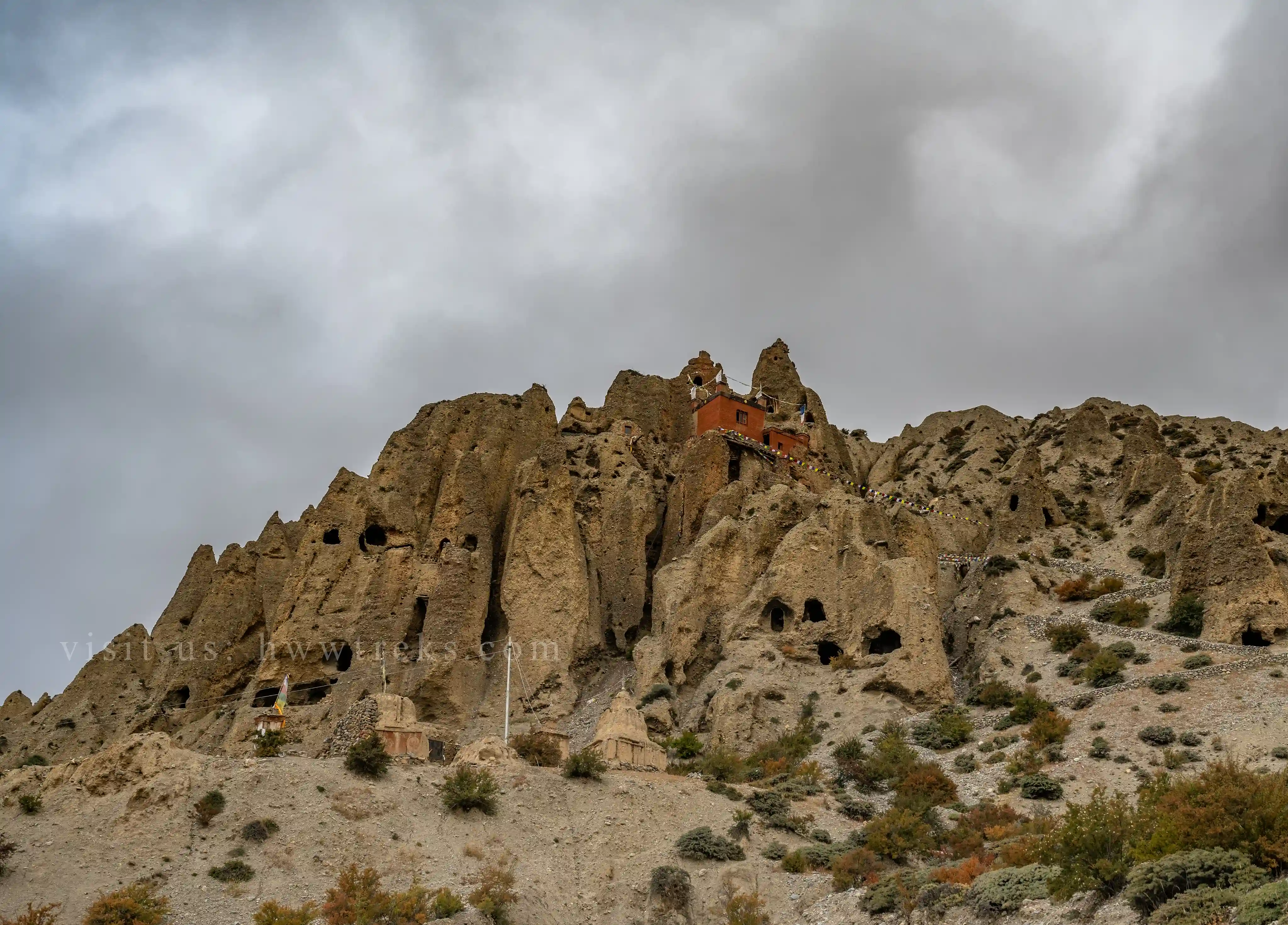 Ghara is a renowned village in Upper Mustang, famous as the gateway to the sacred Buddhist site Luri Gompa and Damodar Kunda. Luri Gompa is a significant Nyingmapa monastery, which contains fascinating wall paintings from the 15th century and sacred murals. The Ghara village is half an hour from Luri Gompa, where travelers pass through while visiting the Gompa. Similar to Yara village, Ghara also has limited guesthouses and hotels for accommodation. People are mostly engaged in farming and animal rearing, although tourism has slightly affected the village. Ghara remains an authentic stopover point where basic teahouse facilities serve trekkers exploring the region's cave monasteries, ancient Buddhist heritage, and dramatic Trans-Himalayan landscapes surrounded by barren cliffs and rugged terrain. The guest house in Gahra village includes:
Ghara is a renowned village in Upper Mustang, famous as the gateway to the sacred Buddhist site Luri Gompa and Damodar Kunda. Luri Gompa is a significant Nyingmapa monastery, which contains fascinating wall paintings from the 15th century and sacred murals. The Ghara village is half an hour from Luri Gompa, where travelers pass through while visiting the Gompa. Similar to Yara village, Ghara also has limited guesthouses and hotels for accommodation. People are mostly engaged in farming and animal rearing, although tourism has slightly affected the village. Ghara remains an authentic stopover point where basic teahouse facilities serve trekkers exploring the region's cave monasteries, ancient Buddhist heritage, and dramatic Trans-Himalayan landscapes surrounded by barren cliffs and rugged terrain. The guest house in Gahra village includes:
| Hotels/ Guest house Name | Contact Number |
| Five Sister Guest House | N/A |
| Tashi Kabum Guest House | N/A |
Hotels and Guesthouse in Tange
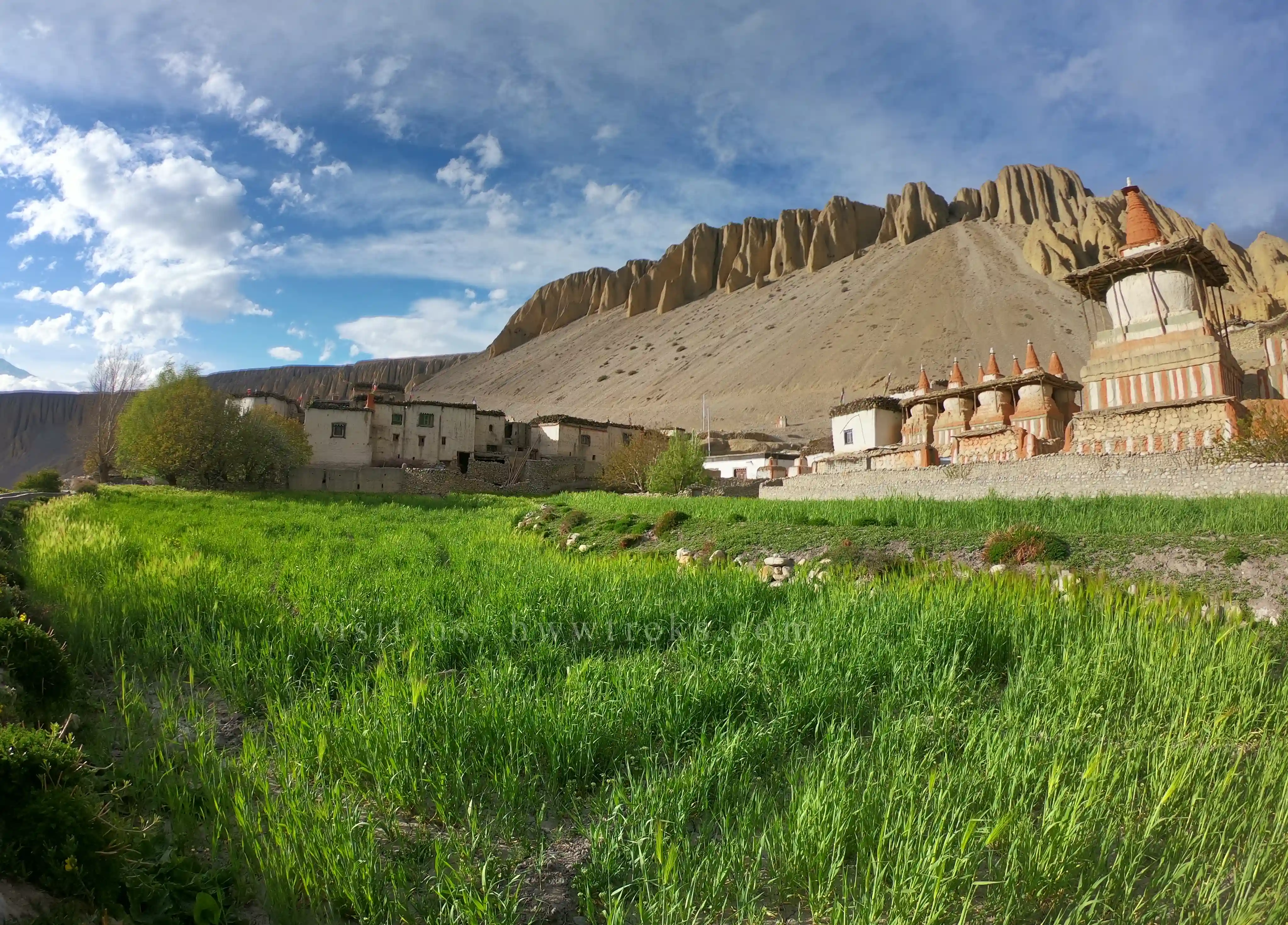 Tange village is isolated from the rest of the villages in Upper Mustang, featuring impressive clusters of eight chortens in the center with red conical-shaped pinnacles that beautify the village. The village can be circled in less than 30 minutes. The village has a favorable climate for cultivation with many crops such as wheat, barley, potato, buckwheat, mustard, and fruits like grapes, apples, and peaches are grown there. Tange people are also involved in animal husbandry. The path to Tange is both challenging and rewarding, offering breathtaking vistas of rugged terrain. There are limited guesthouses in Tange village, and only 1 or 2 have maintained an online presence. Tange remains relatively isolated and authentic, preserving its traditional agricultural lifestyle and spiritual atmosphere. One of the easily reachable guest houses in Tange is:
Tange village is isolated from the rest of the villages in Upper Mustang, featuring impressive clusters of eight chortens in the center with red conical-shaped pinnacles that beautify the village. The village can be circled in less than 30 minutes. The village has a favorable climate for cultivation with many crops such as wheat, barley, potato, buckwheat, mustard, and fruits like grapes, apples, and peaches are grown there. Tange people are also involved in animal husbandry. The path to Tange is both challenging and rewarding, offering breathtaking vistas of rugged terrain. There are limited guesthouses in Tange village, and only 1 or 2 have maintained an online presence. Tange remains relatively isolated and authentic, preserving its traditional agricultural lifestyle and spiritual atmosphere. One of the easily reachable guest houses in Tange is:
| Hotels/Guest house Name | Contact Number |
| Shambhala Guest House | +977 9867974703 |
Hotels and Guest house in Dhi
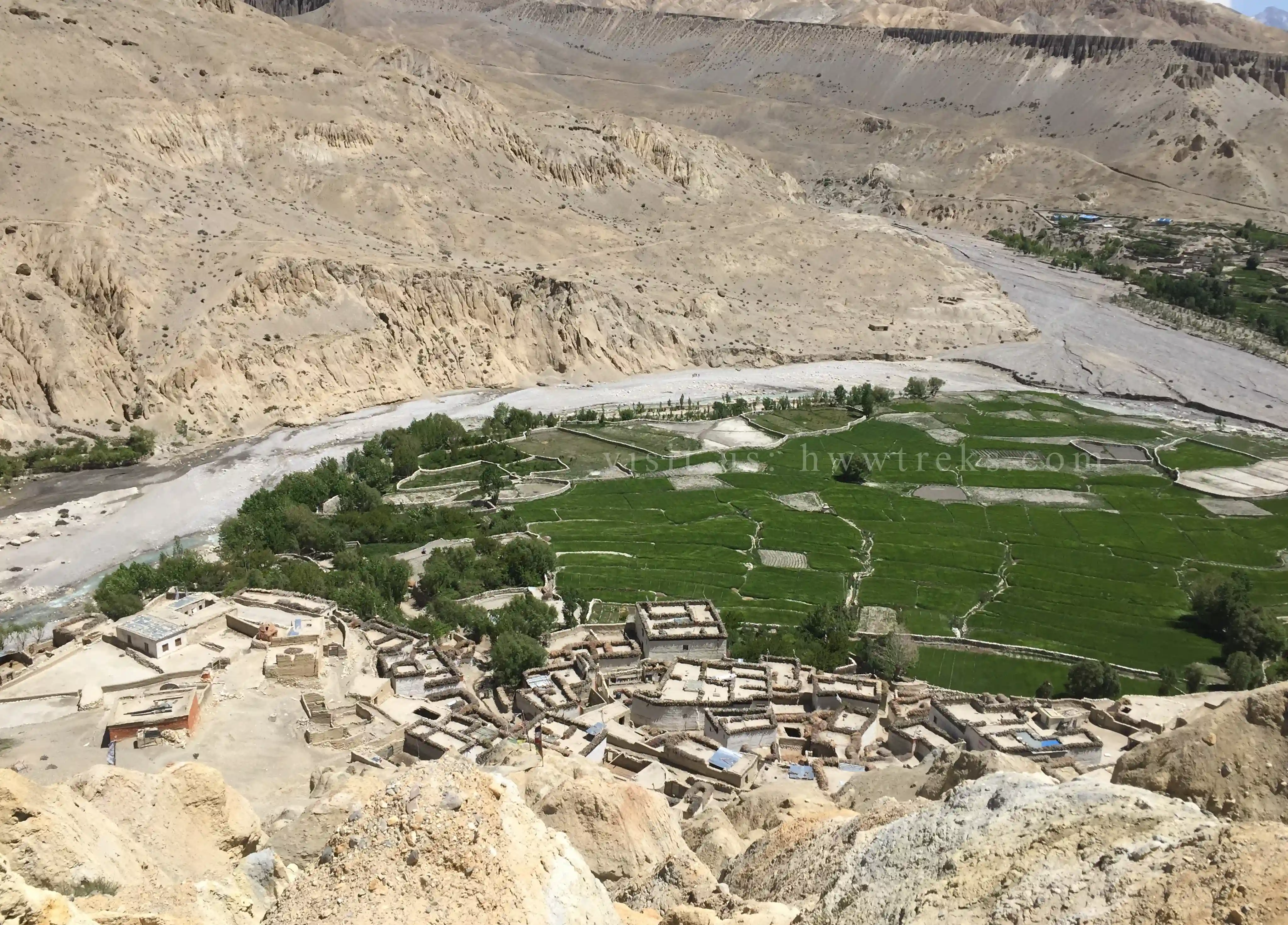 Dhi is a small yet picturesque village where visitors and travelers can enjoy the panoramic view of the mountains and rugged cliffs. Unlike the whitewashed houses, here the village is decorated with the sandy colored buildings. Tourism in Dhi village remains minimal as compared to other settlements in Upper Mustang, and because of that, there are limited yet authentic guest houses run by local families serving traditional Tibetan and Nepali cuisine prepared with locally sourced ingredients. Locals primarily engaged in agriculture and animal husbandry, cultivating barley, buckwheat, and potatoes in terraced fields while raising yaks and goats. Nowadays, people also grow apples, apricots, and other seasonal fruits. The guest house of Dhi village includes:
Dhi is a small yet picturesque village where visitors and travelers can enjoy the panoramic view of the mountains and rugged cliffs. Unlike the whitewashed houses, here the village is decorated with the sandy colored buildings. Tourism in Dhi village remains minimal as compared to other settlements in Upper Mustang, and because of that, there are limited yet authentic guest houses run by local families serving traditional Tibetan and Nepali cuisine prepared with locally sourced ingredients. Locals primarily engaged in agriculture and animal husbandry, cultivating barley, buckwheat, and potatoes in terraced fields while raising yaks and goats. Nowadays, people also grow apples, apricots, and other seasonal fruits. The guest house of Dhi village includes:
| Hotels/ Guest house Name | Contact Number |
| Potala Guest House | +977 9843804385 |
| Hira Guest House | +977 9857650455 |
Hotels and Guest house in Kagbeni
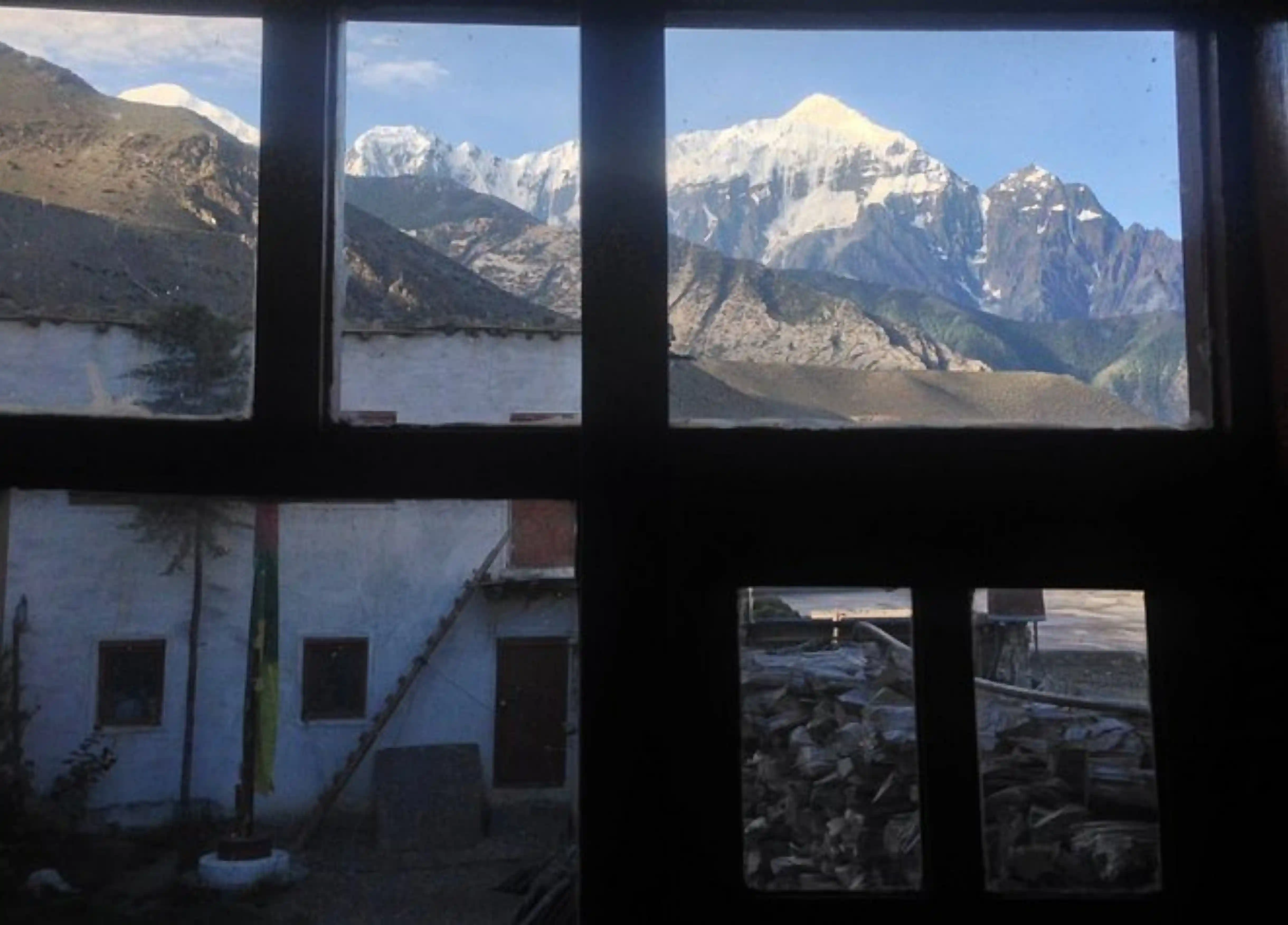 Kagbeni is a beautiful old village located at 2,810 meters, where two rivers, the Kali Gandaki and Jhong, meet together. This historic village is the entry point to Upper Mustang, where trekkers must show their special permits at the checkpoint before going further north into the restricted area. The village has narrow stone pathways running between the mud brick houses with wooden balconies. One of the most impressive sights in Kagbeni is the old red monastery sitting above the village, giving great views of the valleys, snowy mountains, and the dry Mustang landscape ahead. Kagbeni is a popular and busy bus stop and also a part of the Annapurna Circuit Trek route. There are a number of lodges and guest houses providing basic to standard accommodation services to hikers and trekkers. The village has steady electricity and internet connection, along with western cuisine options. Kagbeni is mostly known for its strong afternoon wind, creating an unbearable, steady walk due to dust. Annually, Kagbeni welcomes more than millions of tourists; it has maintained its originality and still performs farming, especially apple farming, and animal husbandry. Some popular lodges and hotels in Kagbeni include:
Kagbeni is a beautiful old village located at 2,810 meters, where two rivers, the Kali Gandaki and Jhong, meet together. This historic village is the entry point to Upper Mustang, where trekkers must show their special permits at the checkpoint before going further north into the restricted area. The village has narrow stone pathways running between the mud brick houses with wooden balconies. One of the most impressive sights in Kagbeni is the old red monastery sitting above the village, giving great views of the valleys, snowy mountains, and the dry Mustang landscape ahead. Kagbeni is a popular and busy bus stop and also a part of the Annapurna Circuit Trek route. There are a number of lodges and guest houses providing basic to standard accommodation services to hikers and trekkers. The village has steady electricity and internet connection, along with western cuisine options. Kagbeni is mostly known for its strong afternoon wind, creating an unbearable, steady walk due to dust. Annually, Kagbeni welcomes more than millions of tourists; it has maintained its originality and still performs farming, especially apple farming, and animal husbandry. Some popular lodges and hotels in Kagbeni include:
| Hotels/ Guest house Name | Contact Number |
| Hotel New Asia | N/A |
| Yac Donald's | +977 9857650508 |
| Paradise Trekkers Home | +977 9846604657 |
| Hotel Tibet | N/A |
| Dragon Hotel | +977 9847680595 |
| Hotel Nilgiri | +977 9847711123 |
| Red House Lodge | +977 9851038325 |
| Hotel Lhasa | +977 9847742510 |
Best Time to Visit Upper Mustang
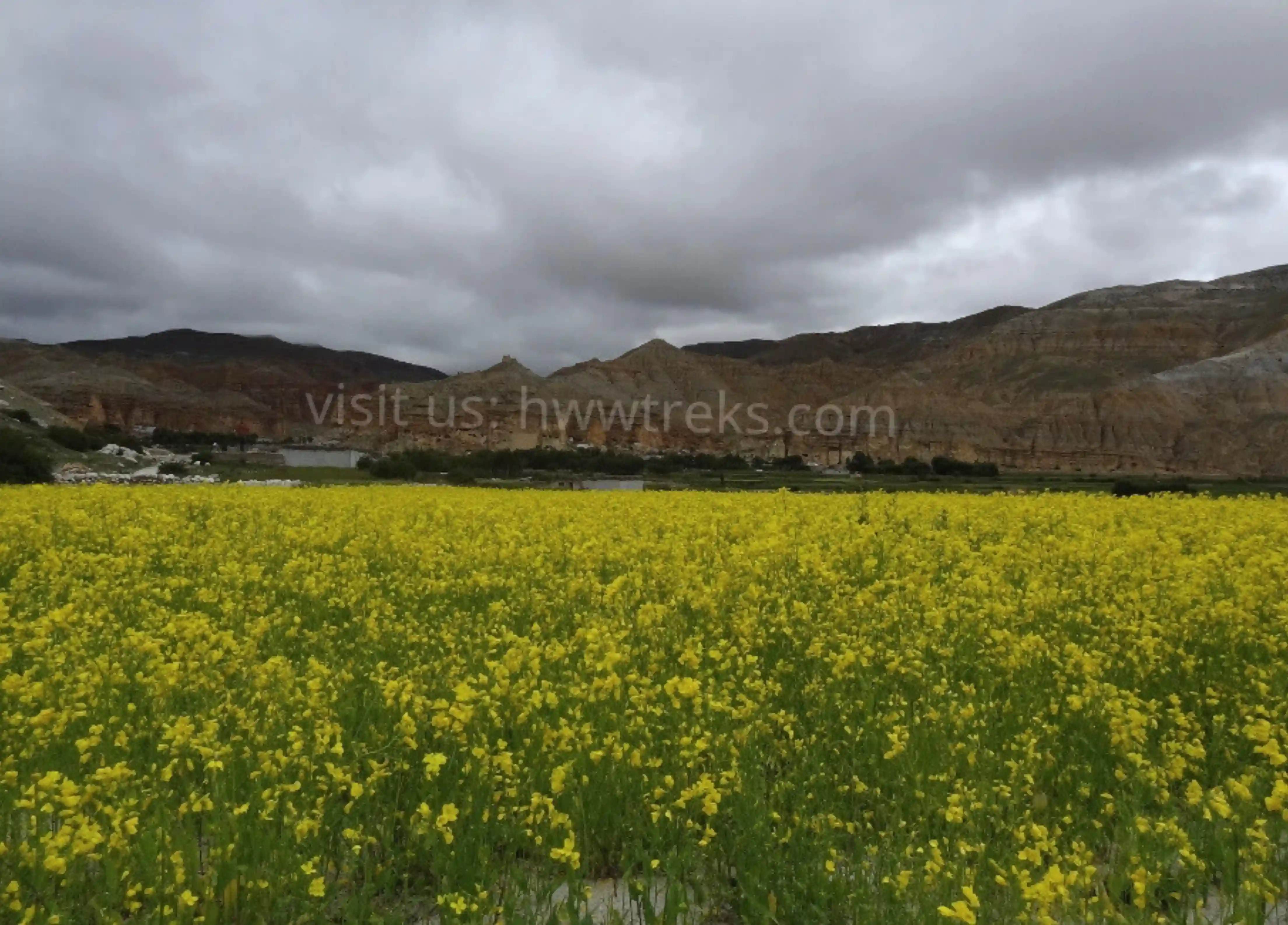
The ideal time to trek Upper Mustang is during spring (March-May) and summer (June-September), when the region comes alive with both trekkers and locals, and also one gets to witness local festivals like the Tiji Festival and the Yartung Festival. Unlike most trekking regions in Nepal, Upper Mustang lies in the rain shadow area North of the Annapurna and Dhaulagiri range, having an advantage during the monsoon season.
One can also trek during the winter season, but since winter is very harsh in the Upper region, the villagers migrate down to Kathmandu and Pokhara, leaving villages relatively empty, and only limited hotels are running with minimum services.
Reminder: Many other accommodations exist throughout Upper Mustang beyond those listed here. Due to limited online visibility, information about these properties may be scarce. Travelers can reach out directly or arrange bookings upon arrival.
How to book hotels in Upper Mustang?
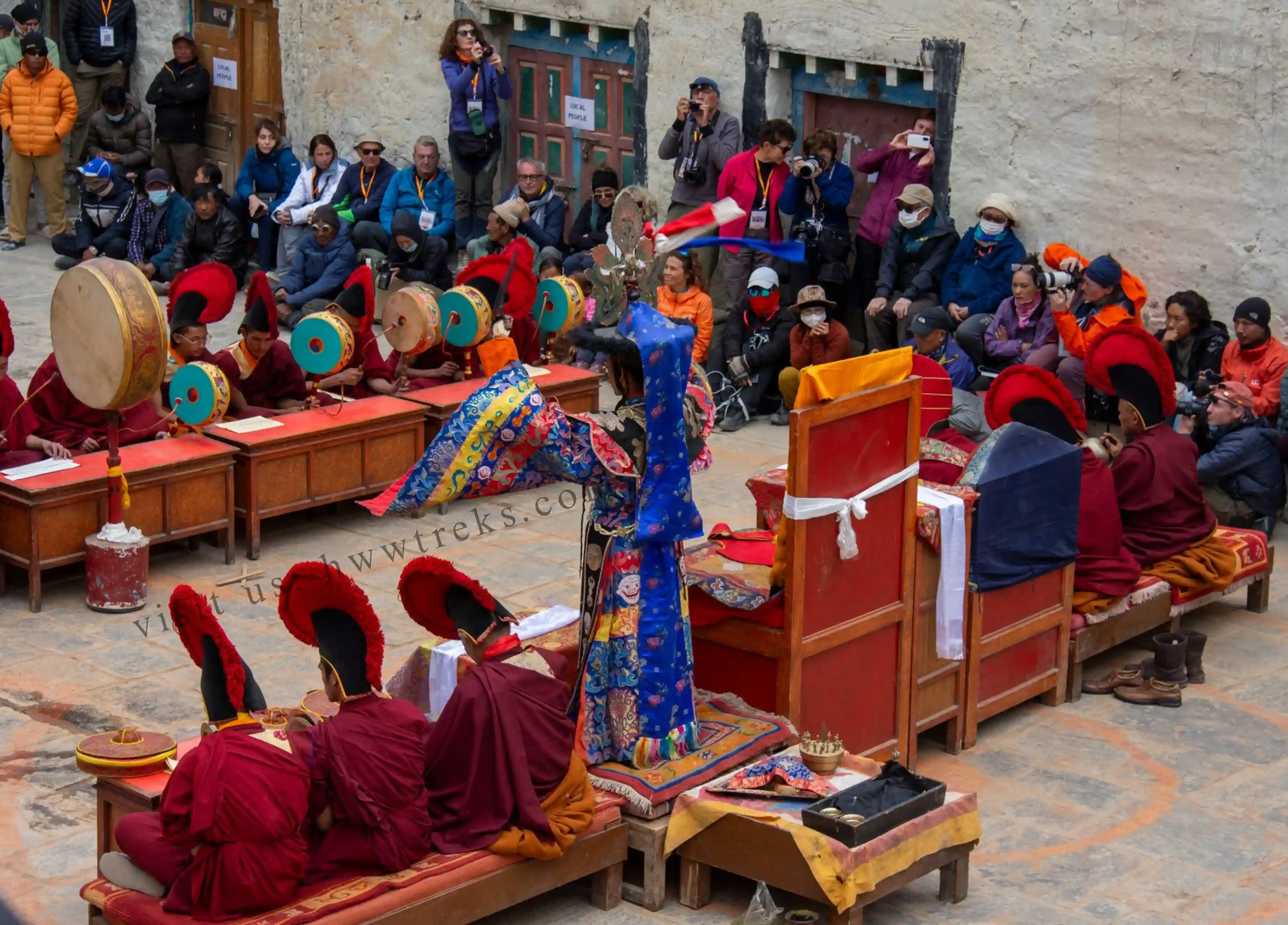
In Upper Mustang, most of the hotels and guesthouses have maintained their online presence through their websites or social media accounts on facebook or in Instagram. You can book your hotel room by contacting them directly via phone call (if you are able to find their contact number) or through email. Whereas if you are traveling with a travel operator, then they will manage all the food and lodging booking.
Keep in mind that bookings in advance are very important while traveling in the Himalayan region, and especially in Upper Mustang during trekking season.
Key Takeaways:
- You can book hotels and lodges in Upper Mustang, directly through phone or email, by finding hotel contact details online
- If you are traveling with a travel operator, then they will handle all bookings
- Booking in advance for Upper Mustang is highly recommended, especially during peak season
Conclusion
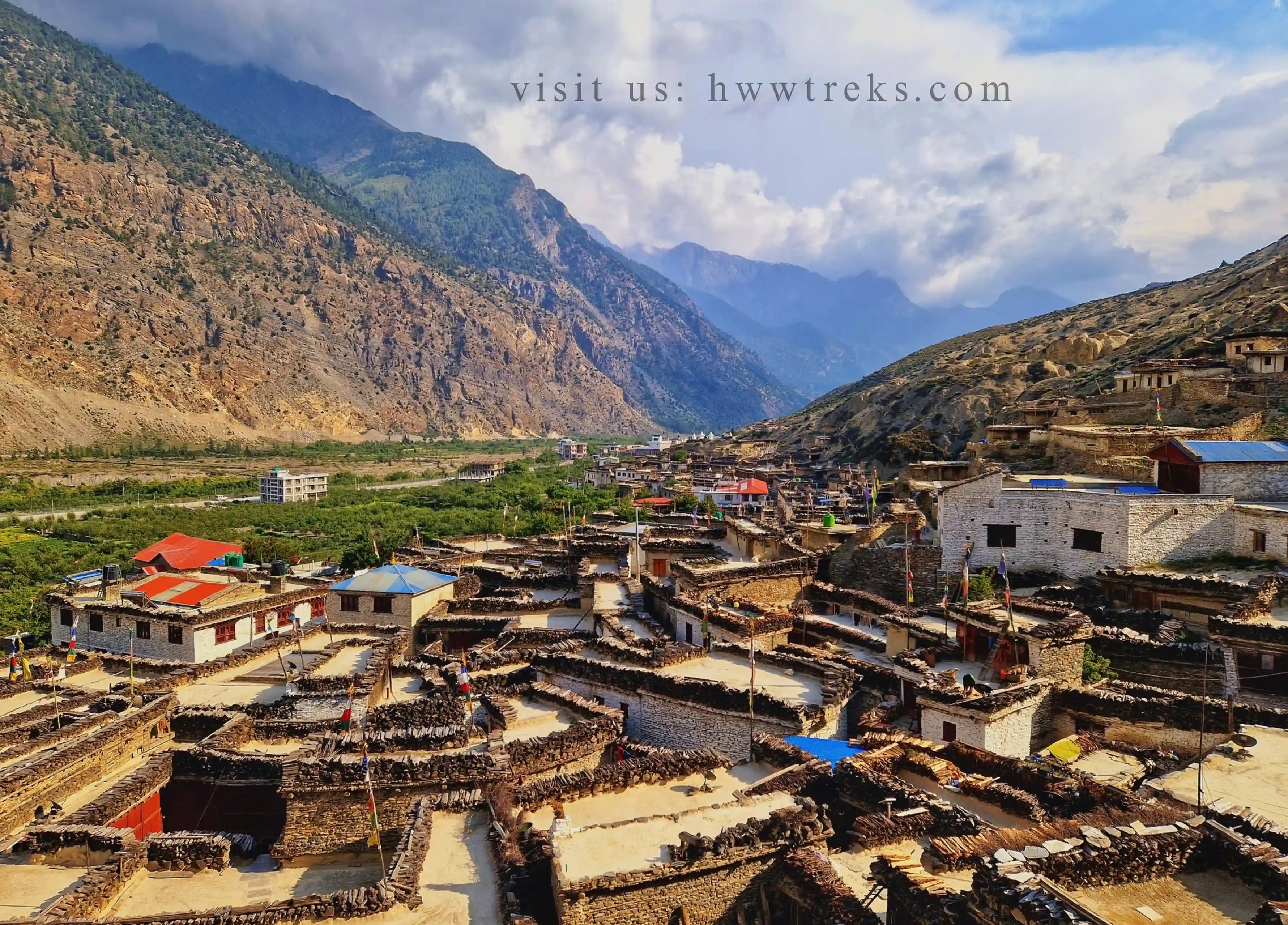 Although it is at a high altitude and in a remote region, the Upper Mustang offers a wide range of accommodation and food services to travelers across its ancient villages. One can choose from basic guest houses to standard lodges with an attached bathroom and a hot shower. Hotels in Upper Mustang have gradually improved their facilities while maintaining the authentic charm that makes this region special. From Lo Manthang to Charang, Ghami to Chuksang, each village provides unique experiences alongside reliable shelter for your trekking journey. The accommodation infrastructure of this region might be limited during the winter season, while spring and summer remain the best seasons to visit, with villages fully operational and local festivals adding cultural richness. These guesthouses and lodges will surely fill your trip with warm wishes and peace of mind.
Although it is at a high altitude and in a remote region, the Upper Mustang offers a wide range of accommodation and food services to travelers across its ancient villages. One can choose from basic guest houses to standard lodges with an attached bathroom and a hot shower. Hotels in Upper Mustang have gradually improved their facilities while maintaining the authentic charm that makes this region special. From Lo Manthang to Charang, Ghami to Chuksang, each village provides unique experiences alongside reliable shelter for your trekking journey. The accommodation infrastructure of this region might be limited during the winter season, while spring and summer remain the best seasons to visit, with villages fully operational and local festivals adding cultural richness. These guesthouses and lodges will surely fill your trip with warm wishes and peace of mind.
Read similar useful blogs regarding travel to Upper Mustang from the below lists:
- Best Treks in Upper Mustang
- Why you should visit Upper Mustang
- When is the next Tiji Festival of Lo Manthang?
- What is actually the Tiji Festival?
- Villages of Upper Mustang
- Three Major Monasteries of Lo Manthang.
- Must-See places of Upper Mustang
- Bagcham of Namgyal Monastery
- Local Trekking and Tour operators For Upper Mustang
- Festivals of Upper Mustang
- Shaligram Shila (ammonite) of Mustang
Frequently Asked Questions
Find answers to common questions about our services
Yes, booking in advance is highly recommended, especially during peak trekking seasons (March-May and September-November). Lodges in popular villages fill up quickly. During the off-season, you may find accommodation on arrival, but booking ahead ensures peace of mind.
Most Upper Mustang hotels offer basic facilities, including simple rooms with beds and blankets, shared bathrooms (some have attached bathrooms), dining areas serving traditional Nepali and Tibetan meals, and solar-powered electricity. Hot showers are available for an extra charge (NPR 200-500). Accommodations are clean but basic.
Some hotels remain open in winter (December-February), particularly in lower areas like Kagbeni and Jomsom. However, many lodges in higher villages like Lo Manthang close due to extreme cold and snow. Always confirm availability before planning a winter trek.
WiFi is available in some guest houses, mainly in larger villages like Kagbeni, Chele, and Lo Manthang. However, it's often slow, unreliable, and may cost extra (NPR 300-500 per day). Don't rely on consistent internet connectivity; consider it a digital detox opportunity.
Yes, most hotels offer device charging, typically powered by solar panels. Charging usually costs NPR 200-500 per device. Bringing a power bank is highly suggested as electricity may be limited during cloudy days or evening hours.
Accommodation costs in Upper Mustang vary depending on the type of lodge:
- Basic teahouses: NPR 500-1,500 ($4-$12 USD) per night
- More comfortable lodges: NPR 2,000-4,000 ($15-$30 USD) per night
Keep in mind that facilities are simpler than in other trekking regions, with most lodges offering basic rooms and shared bathrooms and the price may differ according to seasons.
If your preferred lodge is fully booked, don't worry, lodge owners are generally helpful and can arrange alternative accommodation at nearby guesthouses or suggest the next village along the trail. Your trekking guide can also assist in finding available rooms.
No questions found matching your search. Try different keywords or browse all questions above.
